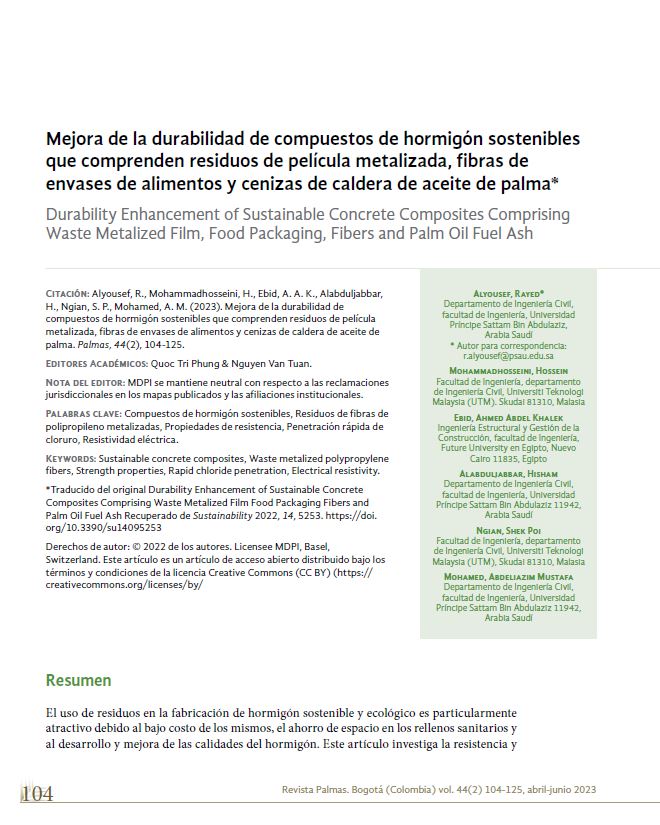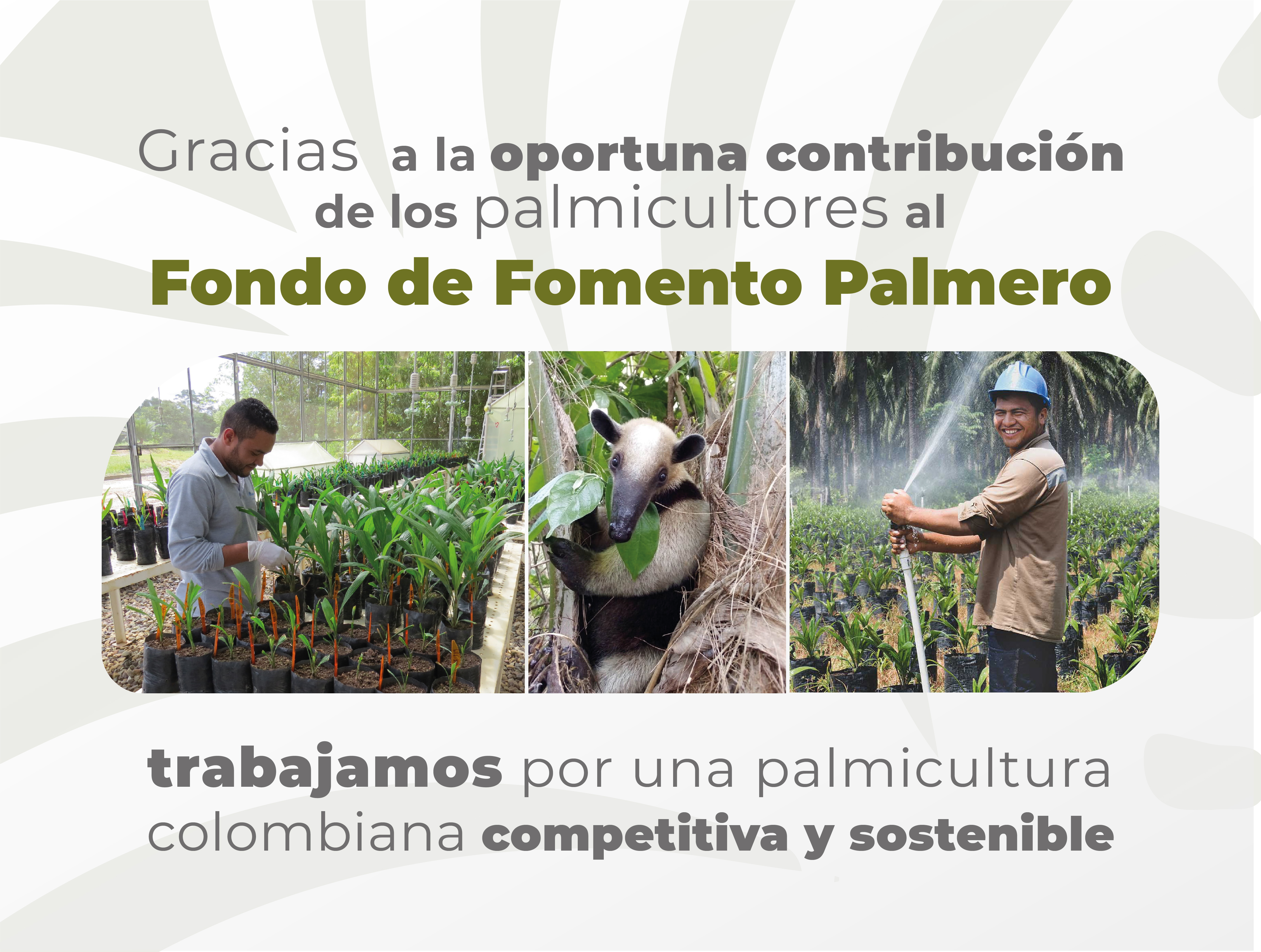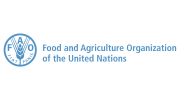Mejora de la durabilidad de compuestos de hormigón sostenibles que comprenden residuos de película metalizada, fibras de envases de alimentos y cenizas de caldera de aceite de palma
Palabras clave:
Compuestos de hormigón sostenibles, Residuos de fibras de polipropileno metalizados, Propiedades de resistencia, Penetración rápida de cloruro, Resistividad eléctricaResumen
El uso de residuos en la fabricación de hormigón sostenible y ecológico es particularmente atractivo debido al bajo costo de los residuos, el ahorro de espacio en los rellenos sanitarios y al desarrollo y mejora de las calidades del hormigón. Este artículo investiga la resistencia y la durabilidad de los compuestos de hormigón ecológico hechos de fibras de envases de alimentos de lámina metalizada (MFP por sus siglas en inglés) y ceniza de caldera de aceite de palma (POFA por sus siglas en inglés). Las propiedades exploradas incluyen las resistencias a la compresión y la tensión, la carbonatación, la contracción por secado, la resistividad eléctrica y las pruebas rápidas de penetración de cloruro en mezclas de hormigón. Con cemento Portland ordinario (CPO), se emplearon fibras MFP de 20 mm de longitud y fracciones de 6 volúmenes que variaban de 0 a 1,25 %. Se hicieron otras 6 mezclas de hormigón con 20 % de POFA en lugar de CPO. Los resultados mostraron que la adición de fibras MFP a las mezclas de hormigón reducía su resistencia a la compresión. Y a pesar de tener una reducción menor en la resistencia a la compresión, la inclusión de fibras MFP aumentó significativamente la resistencia a la tracción. Los hallazgos muestran que la combinación de fibras de MFP con POFA afecta sustancialmente la durabilidad del hormigón. La adición de fibras MFP a las mezclas de hormigón dio como resultado una reducción de la carbonatación y la contracción por secado. También se redujo la penetración de cloruros en las muestras mientras que la resistividad eléctrica de las muestras reforzadas aumentó casi un 80 en comparación con el hormigón ordinario.
Referencias bibliográficas
Sun, C.; Chen, Q.; Xiao, J.; Liu, W. Utilization of waste concrete recycling materials in self-compacting concrete. Resour. Conserv. Recycl. 2020, 161, 104930. [CrossRef]
Choudhary, J.; Kumar, B.; Gupta, A. Feasible utilization of waste limestone sludge as filler in bituminous concrete. Constr. Build. Mater. 2020, 239, 117781. [CrossRef]
Mohammadhosseini, H.; Yatim, J. M.; Sam, A. R. M.; Awal, A. A. Durability performance of green concrete composites containing waste carpet fibers and palm oil fuel ash. J. Clean. Prod. 2017, 144, 448-458. [CrossRef]
Siddique, R.; Singh, G. Utilization of waste foundry sand (WFS) in concrete manufacturing. Resour. Conserv. Recycl. 2011, 55, 885-892. [CrossRef]
Alaskar, A.; Alqarni, A. S.; Alfalah, G.; El-Sayed, A. K.; Mohammadhosseini, H.; Alyousef, R. Performance evaluation of reinforced concrete beams with corroded web reinforcement: Experimental and theoretical study. J. Build. Eng. 2021, 35, 102038. [CrossRef]
Mohammadhosseini, H.; Alyousef, R.; Poi Ngian, S.; Tahir, M. M. Performance evaluation of sustainable concrete comprising waste polypropylene food tray fibers and palm oil fuel ash exposed to sulfate and acid attacks. Crystals 2021, 11, 966. [CrossRef]
Gu, L.; Ozbakkaloglu, T. Use of recycled plastics in concrete: A critical review. Waste Manag. 2016, 51, 19-42. [CrossRef]
Sharma, R.; Bansal, P.P. Use of different forms of waste plastic in concrete-A review. J. Clean. Prod. 2016, 112, 473-482. [CrossRef]
Saikia, N.; de Brito, J. Use of plastic waste as aggregate in cement mortar and concrete preparation: A review. Constr. Build. Mater. 2012, 34, 385-401. [CrossRef]
Albano, C.; Camacho, N.; Hernández, M.; Matheus, A.; Gutiérrez, A. Influence of content and particle size of waste pet bottles on concrete behavior at different w/c ratios. Waste Manag. 2009, 29, 2707-2716. [CrossRef]
Eriksen, M.; Christiansen, J.; Daugaard, A. E.; Astrup, T. Closing the loop for PET, PE and PP waste from households: Influence of material properties and product design for plastic recycling. Waste Manag. 2019, 96, 75-85. [CrossRef] [PubMed]
Faraca, G.; Astrup, T. Plastic waste from recycling centres: Characterisation and evaluation of plastic recyclability. Waste Manag. 2019, 95, 388-398. [CrossRef] [PubMed]
Hahladakis, J. N.; Iacovidou, E. An overview of the challenges and trade-offs in closing the loop of post-consumer plastic waste (PCPW): Focus on recycling. J. Hazard. Mater. 2019, 380, 120887. [CrossRef]
Eriksen, M.; Astrup, T. Characterisation of source-separated, rigid plastic waste and evaluation of recycling initiatives: Effects of product design and source-separation system. Waste Manag. 2019, 87, 161-172. [CrossRef] [PubMed]
Mohammadhosseini, H.; Alyousef, R.; Lim, N. H. A. S.; Tahir, M. M.; Alabduljabbar, H.; Mohamed, A. M.; Samadi, M. Waste metalized film food packaging as low cost and ecofriendly fibrous materials in the production of sustainable and green concrete composites. J. Clean. Prod. 2020, 258, 120726. [CrossRef]
Mahmood, R. A.; Kockal, N. U. Cementitious materials incorporating waste plastics: A review. SN Appl. Sci. 2020, 2, 1-13. [CrossRef]
Buller, A. S.; Abro, F. U. R.; Lee, K. -M.; Jang, S. Y. Mechanical Recovery of Cracked Fiber-Reinforced Mortar Incorporating Crystalline Admixture, Expansive Agent, and Geomaterial. Adv. Mater. Sci. Eng. 2019, 2019, 3420349. [CrossRef]
Liu, F.; Zhang, T.; Luo, T.; Zhou, M.; Ma, W.; Zhang, K. The effects of Nano-SiO2 and Nano-TiO2 addition on the durability and deterioration of concrete subject to freezing and thawing cycles. Materials 2019, 12, 3608. [CrossRef]
Yi, Y.; Zhu, D.; Guo, S.; Zhang, Z.; Shi, C. A review on the deterioration and approaches to enhance the durability of concrete in the marine environment. Cem. Concr. Compos. 2020, 113, 103695. [CrossRef]
Paul, S. C.; Van Zijl, G. P.; Šavija, B. Effect of Fibers on Durability of Concrete: A Practical Review. Materials 2020, 13, 4562. [CrossRef]
Abro, F. U. R.; Buller, A. S.; Lee, K. -M.; Jang, S. Y. Using the Steady-State Chloride Migration Test to Evaluate the Self-Healing Capacity of Cracked Mortars Containing Crystalline, Expansive, and Swelling Admixtures. Materials 2019, 12, 1865. [CrossRef] [PubMed]
Buller, A. S.; Abro, F. -U. -R.; Ali, T.; Jakhrani, S. H.; Ul-Abdin, Z. Stimulated autogenous-healing capacity of fiber-reinforced mortar incorporating healing agents for recovery against fracture and mechanical properties. Mater. Sci. 2021, 39, 33-48. [CrossRef]
Alrshoudi, F.; Mohammadhosseini, H.; Md. Tahir, M.; Alyousef, R.; Alghamdi, H.; Alharbi, Y. R.; Alsaif, A. Sustainable use of waste polypropylene fibers and palm oil fuel ash in the production of novel prepacked aggregate fiber-reinforced concrete. Sustainability 2020, 12, 4871. [CrossRef]
Alnahhal, M. F.; Alengaram, U. J.; Jumaat, M. Z.; Alsubari, B.; Alqedra, M. A.; Mo, K. H. Effect of aggressive chemicals on durability and microstructure properties of concrete containing crushed new concrete aggregate and non-traditional supplementary cementitious materials. Constr. Build. Mater. 2018, 163, 482-495. [CrossRef]
Wang, W.; Shen, A.; Lyu, Z.; He, Z.; Nguyen, K. T. Fresh and rheological characteristics of fiber reinforced concrete-A review. Constr. Build. Mater. 2021, 296, 123734. [CrossRef]
Mujedu, K. A.; Ab-Kadir, M. A.; Ismail, M. A review on self-compacting concrete incorporating palm oil fuel ash as a cement replacement. Constr. Build. Mater. 2020, 258, 119541. [CrossRef]
Mohammadhosseini, H.; Alrshoudi, F.; Tahir, M. M.; Alyousef, R.; Alghamdi, H.; Alharbi, Y. R.; Alsaif, A. Durability and thermal properties of prepacked aggregate concrete reinforced with waste polypropylene fibers. J. Build. Eng. 2020, 32, 101723. [CrossRef]
Turk, K.; Bassurucu, M.; Bitkin, R. E. Workability, strength and flexural toughness properties of hybrid steel fiber reinforced SCC with high-volume fiber. Constr. Build. Mater. 2021, 266, 120944. [CrossRef]
Zhang, P.; Li, Q. Fracture properties of polypropylene fiber reinforced concrete containing fly ash and silica fume. Res. Appl. Sci. Eng. Technol. 2013, 5, 665-670. [CrossRef]
Li, Y.; Su, Y.; Tan, K. H.; Zheng, X.; Sheng, J. Pore structure and splitting tensile strength of hybrid Basalt-Polypropylene fiber reinforced concrete subjected to carbonation. Constr. Build. Mater. 2021, 297, 123779. [CrossRef]
Bao, H.; Yu, M.; Chi, Y.; Liu, Y.; Ye, J. Performance evaluation of steel-polypropylene hybrid fiber reinforced concrete under supercritical carbonation. J. Build. Eng. 2021, 43, 103159. [CrossRef]
Almeida, A. E. F. S.; Tonoli, G. H. D.; Santos, S. F.; Savastano, H., Jr. Improved durability of vegetable fiber reinforced cement composite subject to accelerated carbonation at early age. Cem. Concr. Compos. 2013, 42, 49-58. [CrossRef]
Tang, W. L.; Lee, H. -S.; Vimonsatit, V.; Htut, T.; Singh, J. K.; Hassan, W. N. F. W.; Ismail, M. A.; Seikh, A. H.; Alharthi, N. Optimization of Micro and Nano Palm Oil Fuel Ash to Determine the Carbonation Resistance of the Concrete in Accelerated Condition. Materials 2019, 12, 130. [CrossRef] [PubMed]
Mohammadhosseini, H.; Alrshoudi, F.; Tahir, M.M.; Alyousef, R.; Alghamdi, H.; Alharbi, Y. R.; Alsaif, A. Performance evaluation of novel prepacked aggregate concrete reinforced with waste polypropylene fibers at elevated temperatures. Constr. Build. Mater. 2020, 259, 120418. [CrossRef]
Karahan, O.; Atis, C. The durability properties of polypropylene fiber reinforced fly ash concrete. Mater. Des. 2011, 32, 1044-1049. [CrossRef]
Teng, S.; Afroughsabet, V.; Ostertag, C. P. Flexural behavior and durability properties of high performance hybrid-fiber-reinforced concrete. Constr. Build. Mater. 2018, 182, 504-515. [CrossRef]
Wang, L.; Aslani, F. Electrical resistivity and piezoresistivity of cement mortar containing ground granulated blast furnace slag. Constr. Build. Mater. 2020, 263, 120243. [CrossRef]
Neville, A. M.; Brooks, J. J. Concrete Technology, 2da ed.; Longman Scientific & Technical: London, UK, 2010.
Lim, T. Y. D.; Teng, S.; Bahador, S. D.; Gjørv, O. E. Durability of Very-High-Strength Concrete with Supplementary Cementitious Materials for Marine Environments. ACI Mater. J. 2016, 113, 95-103. [CrossRef]
Zhang, M.; Li, H. Pore structure and chloride permeability of concrete containing nano-particles for pavement. Constr. Build. Mater. 2011, 25, 608-616. [CrossRef]
Abro, F. U. R.; Buller, A. S.; Ali, T.; Ul-Abdin, Z.; Ahmed, Z.; Memon, N. A.; Lashari, A. R. Autogenous Healing of Cracked Mortar Using Modified Steady-State Migration Test against Chloride Penetration. Sustainability 2021, 13, 9519. [CrossRef]
Afroughsabet, V.; Biolzi, L.; Monteiro, P. J. The effect of steel and polypropylene fibers on the chloride diffusivity and drying shrinkage of high-strength concrete. Compos. Part B Eng. 2018, 139, 84-96. [CrossRef]
Kroehong, W.; Damrongwiriyanupap, N.; Sinsiri, T.; Jaturapitakkul, C. The Effect of Palm Oil Fuel Ash as a Supplementary Cementitious Material on Chloride Penetration and Microstructure of Blended Cement Paste. Arab. J. Sci. Eng. 2016, 41, 4799-4808. [CrossRef]
Alnahhal, A. M.; Alengaram, U. J.; Yusoff, S.; Singh, R.; Radwan, M. K.; Deboucha, W. Synthesis of sustainable lightweight foamed concrete using palm oil fuel ash as a cement replacement material. J. Build. Eng. 2021, 35, 102047. [CrossRef]
Kroehong, W.; Sinsiri, T.; Jaturapitakkul, C.; Chindaprasirt, P. Effect of palm oil fuel ash fineness on the microstructure of blended cement paste. Constr. Build. Mater. 2011, 25, 4095-4104. [CrossRef]
Mohammadhosseini, H.; Alyousef, R.; Md. Tahir, M. Towards Sustainable Concrete Composites through Waste Valorisation of Plastic Food Trays as Low-Cost Fibrous Materials. Sustainability 2021, 13, 2073. [CrossRef]
Alrshoudi, F.; Mohammadhosseini, H.; Alyousef, R.; Tahir, M.M.; Alabduljabbar, H.; Mustafa Mohamed, A. The impact resistance and deformation performance of novel pre-packed aggregate concrete reinforced with waste polypropylene fibres. Crystals 2020, 10, 788. [CrossRef]
Cómo citar
Descargas

Publicado
Número
Sección
Licencia
Derechos de autor 2023 Palmas

Esta obra está bajo una licencia internacional Creative Commons Atribución-NoComercial-SinDerivadas 4.0.














